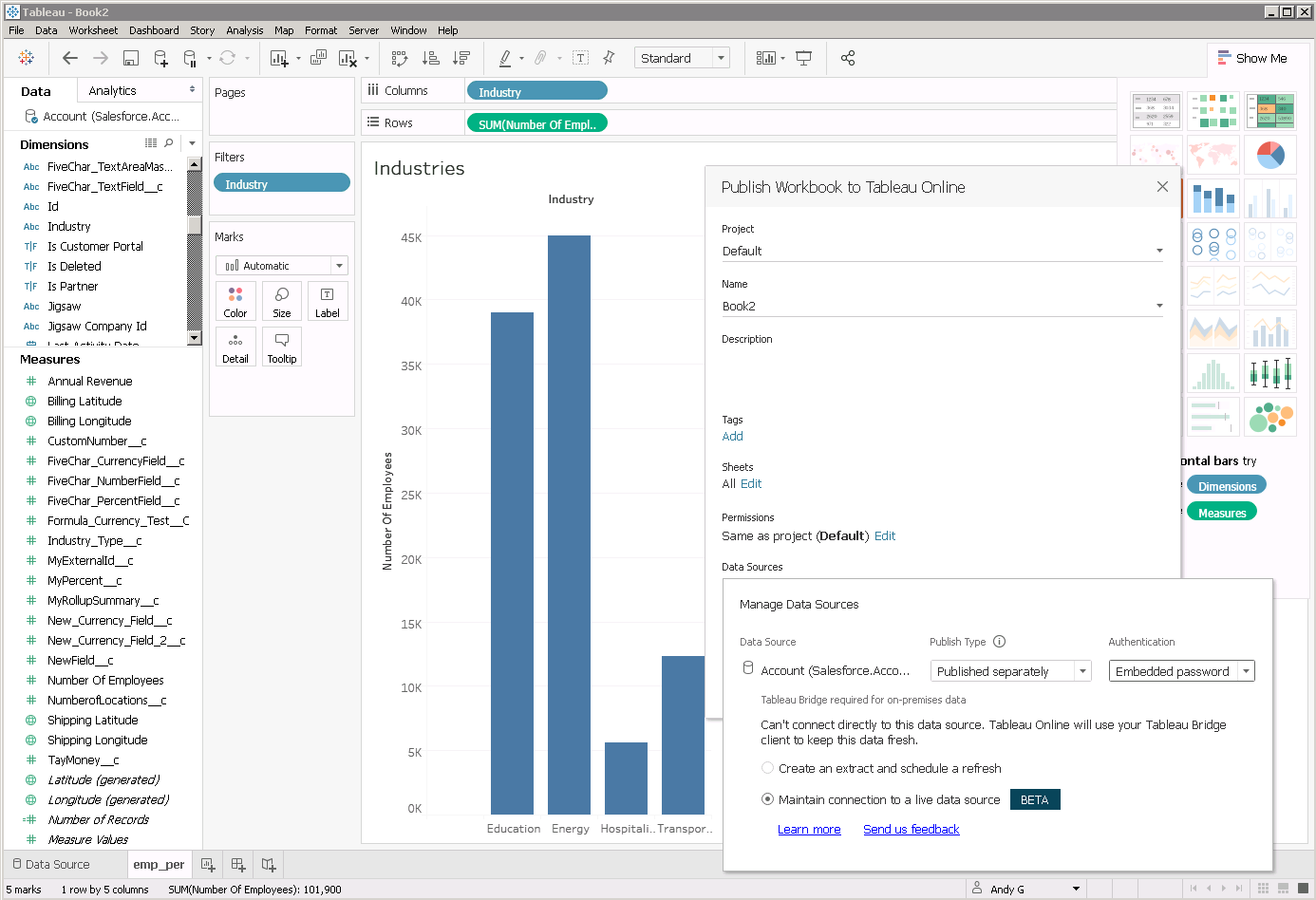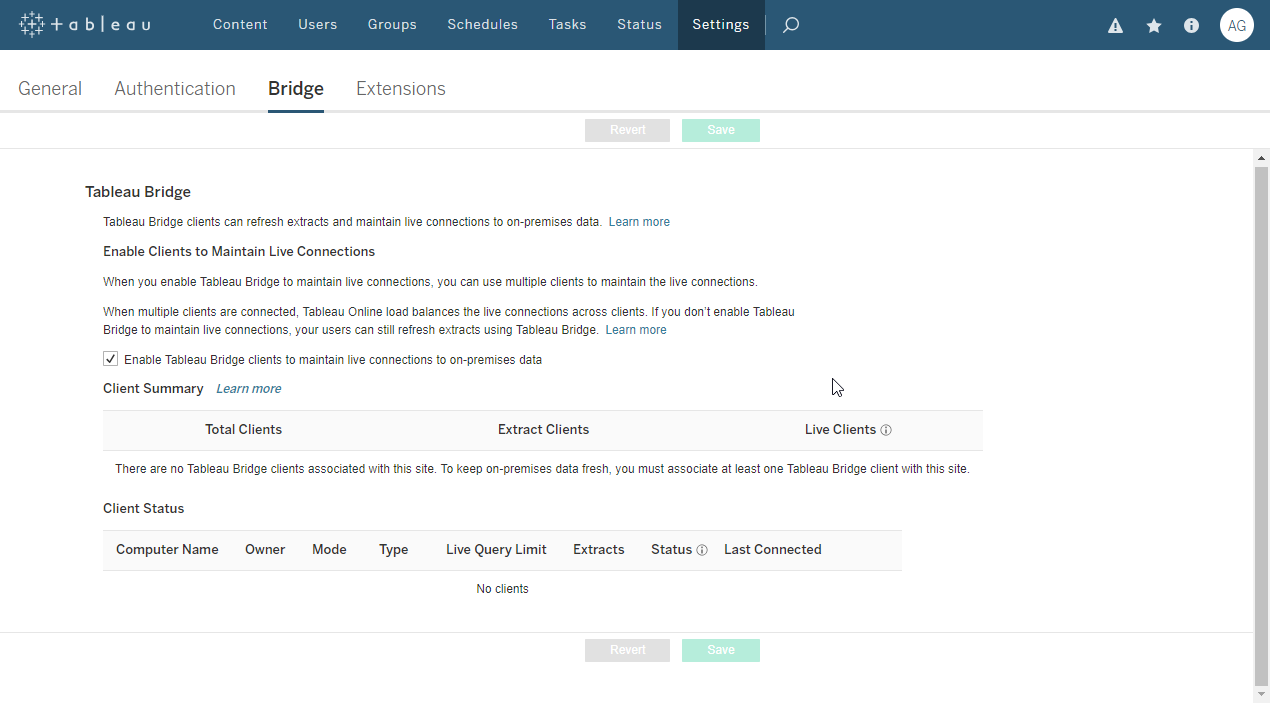Discover how a bimodal integration strategy can address the major data management challenges facing your organization today.
Get the Report →Establish a Live Connection with Paylocity Data using Tableau Bridge
The CData ODBC Driver for Paylocity enables you to integrate live Paylocity data into Tableau Cloud dashboards using the Tableau Bridge.
The Tableau Bridge enables you to publish dashboards to Tableau Cloud while maintaining live connectivity with any data source. In this article, you will use the Tableau Bridge to maintain data freshness in a published workbook by listening for changes in the underlying Paylocity data.
The CData ODBC drivers offer unmatched performance for interacting with live Paylocity data in Tableau Cloud due to optimized data processing built into the driver. When you issue complex SQL queries from Tableau Cloud to Paylocity, the driver pushes supported SQL operations, like filters and aggregations, directly to Paylocity and utilizes the embedded SQL engine to process unsupported operations (often SQL functions and JOIN operations) client-side. With built-in dynamic metadata querying, you can visualize and analyze Paylocity data using native Tableau data types.
Connect to Paylocity as an ODBC Data Source
If you have not already, first specify connection properties in an ODBC DSN (data source name). This is the last step of the driver installation. You can use the Microsoft ODBC Data Source Administrator to create and configure ODBC DSNs.
Set the following to establish a connection to Paylocity:
- RSAPublicKey: Set this to the RSA Key associated with your Paylocity, if the RSA Encryption is enabled in the Paylocity account.
This property is required for executing Insert and Update statements, and it is not required if the feature is disabled.
- UseSandbox: Set to true if you are using sandbox account.
- CustomFieldsCategory: Set this to the Customfields category. This is required when IncludeCustomFields is set to true. The default value for this property is PayrollAndHR.
- Key: The AES symmetric key(base 64 encoded) encrypted with the Paylocity Public Key. It is the key used to encrypt the content.
Paylocity will decrypt the AES key using RSA decryption.
It is an optional property if the IV value not provided, The driver will generate a key internally. - IV: The AES IV (base 64 encoded) used when encrypting the content. It is an optional property if the Key value not provided, The driver will generate an IV internally.
Connect Using OAuth Authentication
You must use OAuth to authenticate with Paylocity. OAuth requires the authenticating user to interact with Paylocity using the browser. For more information, refer to the OAuth section in the Help documentation.
The Pay Entry API
The Pay Entry API is completely separate from the rest of the Paylocity API. It uses a separate Client ID and Secret, and must be explicitly requested from Paylocity for access to be granted for an account. The Pay Entry API allows you to automatically submit payroll information for individual employees, and little else. Due to the extremely limited nature of what is offered by the Pay Entry API, we have elected not to give it a separate schema, but it may be enabled via the UsePayEntryAPI connection property.
Please be aware that when setting UsePayEntryAPI to true, you may only use the CreatePayEntryImportBatch & MergePayEntryImportBatchgtable stored procedures, the InputTimeEntry table, and the OAuth stored procedures. Attempts to use other features of the product will result in an error. You must also store your OAuthAccessToken separately, which often means setting a different OAuthSettingsLocation when using this connection property.
When you configure the DSN, you may also want to set the Max Rows connection property. This will limit the number of rows returned, which is especially helpful for improving performance when designing reports and visualizations.
Add Paylocity Data to a Dashboard
- From a new workbook, click Data -> New Data Source -> Other Databases (ODBC).
Select the CData Data Source Name (for example: CData Paylocity Source). - In the Database menu, select CData.
- In the Table box, enter a table name or click New Custom SQL to enter an SQL query. This article retrieves the Employee table.
- Drag the table onto the join area. At this point, you can include multiple tables, leveraging the built-in SQL engine to process complex data requests.
- Click the tab for your worksheet. Columns are listed as Dimensions and Measures, which you can drag and drop onto the dashboard to create visualizations.
![A connection to a single table. (Salesforce is shown.)]()
Set Up Tableau Bridge as a Service
- In the Server menu, select Start Tableau Bridge Client.
- Sign in to the Tableau Bridge using a site admin level account.
- If prompted, select the Tableau Cloud site where you want to publish live data. The bridge client will open and is accessible from the system tray.
- By default, the Tableau Bridge client is set to Application mode. Select 'Switch to service' to enable Tableau Bridge to handle live connections.
- Log in to your Tableau Cloud site as an administrator.
- From your site, click Settings, then Bridge.
![The Tableau Bridge settings within Tableau Cloud.]()
- In the Bridge settings, under Enable Clients to Maintain Live Connections, check the box labeled 'Enable Tableau Bridge clients to maintain live connections to on-premises data.'
Publish a Dashboard Containing the Live Data Source
Having configured both the Tableau Bridge and Tableau Cloud to enable live data connections, you can now publish your workbook to Tableau Cloud. From the Server menu, select Publish Workbook.

After choosing the workbook name and project that you wish to publish to, configure the deployment so that the CData ODBC driver for Paylocity is embedded in your workbook as a separate, live data source.
- Under Data Sources, select the option to Edit the embedded data sources in the workbook.
- Change Publish Type to 'Published separately,' then select a desired means of authentication.
- Last, select 'Maintain connection to a live data source' and click the green Publish Workbook button.
The published workbook now updates alongside the underlying Paylocity data. From a published dashboard, simply click the Refresh button to reflect the most recent changes.








